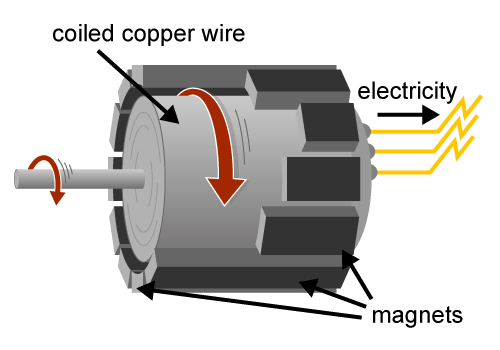A generator is a device that converts kinetic energy into electric energy. Generators are used as back up power sources during storms, emergencies, or any other sort of power outages to keep crucial electronics running. Generators may also be used as sources of electricity where outlets or other power sources are not readily available. There are different ways in which they convert kinetic energy into electricity. This article covers the basic functioning of a generator, different types, and the associated maintenance.

How it Works

The main operating principle of a generator is the conversion of kinetic energy into electrical energy. Generators operate off the findings of Michael Faraday who discovered that electric current that flows in a wire when a magnet is moved inside it. From this principle, the general design of a generator was made. The assembly of the typical generator utilizes an electromagnetic shaft that rotates, inducing an electric current inside a copper coil. When the shaft rotates, electricity is produced by the magnet and the coil.
The shaft attaches to a cylinder assembly that encases the shaft. The shaft, when rotated, induces a small current in various sections of the copper coil inside the cylinder each of which act as conductors for the produced electricity. These small interactions combine to make one large output current. The method in which the shaft is rotated is where the variety in the different types of generators come into play.
Most generators operate from this general design of converting mechanical energy into electric energy. However, several types of generators use other forms of kinetic energy to supply electric energy.
Different Types
Proper specification of a generator involves an understanding of site conditions, fuel availability, and performance requirements. Generators can be categorized into groups based on the type of fuel used and function Groupings are as follows: on-demand gas, standby gas, diesel, natural gas, solar, inverter, and hydrogen.
On-Demand Gas Powered Generator

On-demand gasoline-powered generators operate off a combustion engine to rotate the electromagnetic shaft assembly. As gasoline is readily available, this type of generator is easily portable and one of the most popular types of generator to use for residential and consumer purposes. They have a generally small output and are ideal for smaller applications.
Standby Gas Generator

Standby generators function the same as on-demand gas-powered generators but are categorized differently as they are used for much bigger applications. Where a regular generator is used to power something for shorter spans of time, standby generators have much larger fuel reserves and automatic transfer switch. In the case of emergency power outages for houses, elevators, or even life support devices, standby generators offer instantaneous power transfer to keep devices running in emergency situations.
Diesel Generator

Diesel generators, similar to gasoline generators, operate off combustion engines to rotate the electromagnetic shaft assembly. The major difference is the diesel fuel used. Diesel as a fuel source holds more energy per gallon than gas making the diesel generator a bit more durable and efficient.
Natural Gas Generator

Natural gas generators are combustion generators that operate by burning natural gas. They are for larger residential uses such as providing electricity for long periods of time to off grid locations such as cabins. They are much larger and far less portable than other types of generators.
Solar Generator

Solar generators, unlike most other generators, do not rely on electrical inductance. They use solar panels to capture and store radiation emitted by the sun in the form of electric energy. Solar panels allow photons to alter electrons in the photovoltaic cells found in the panel which in tern produce an electric current which is later stored in a battery to be used on smaller scales. The same principal is how solar panels operate on residential housing.
Inverter Generator

Inverter generators utilize alternators to produce electricity. Initially, the generator utilizes the alternator to output and AC current which is the converted to DC power. The inverter in the generator then converts the power back to AC for steady and smooth output. They are efficient and extremely quiet making them ideal for smaller residential applications.
Hydrogen Generator

Hydrogen generators produce electric power by using fuel cells. Fuel cells split the electrons from the protons in the hydrogen gas and collect the electrons at an anode. The flow of the electrons creates a current that is then used for power. Currently, they are operated at smaller scales and their only by-products are warm air and water vapor.
Maintenance
The maintenance of generators depends heavily on the type of generator and the operating conditions they will be used in. For combustion-based generators, ensuring proper combustion, lubrication, and fuel levels are the major priorities in keeping a generator healthy. Similarly, being mindful of ideal operating temperatures and other environmental factors are important considerations to make when operating. For solar non-combustion generators, ensuring the proper electrical output is crucial to maintaining the desired output of the generator especially when being used for medical devices or as an emergency backup power source.



